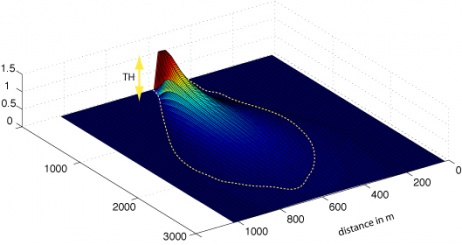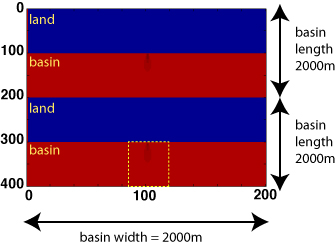Model:Plume: Difference between revisions
(added model) |
m (Text replacement - "{{End headertab}}" to "{{End headertab}} {{{{PAGENAME}}_autokeywords}}") |
||
| (53 intermediate revisions by 3 users not shown) | |||
| Line 1: | Line 1: | ||
{{ | {{Model identity | ||
| | |Model type=Single | ||
}} | }} | ||
{{Start models incorporated}} | |||
{{End a table}} | |||
{{Model identity2 | |||
|ModelDomain=Coastal, Marine | |||
|Spatial dimensions=2D | |||
|One-line model description=Hypopycnal sediment plume | |||
|Extended model description=Run a hypopycnal sediment plume | |||
}} | |||
{{Start model keyword table}} | |||
{{Model keywords | |||
|Model keywords=sediment transport | |||
}} | |||
{{End a table}} | |||
{{Modeler information | |||
|First name=Eric | |||
|Last name=Hutton | |||
|Type of contact=Model developer | |||
|Institute / Organization=CSDMS, INSTAAR, University of Colorado | |||
|Postal address 1=1560 30th street | |||
|Town / City=Boulder | |||
|Postal code=80305 | |||
|Country=United States | |||
|State=Colorado | |||
|Email address=huttone@colorado.edu | |||
}} | |||
{{Model technical information | |||
|Supported platforms=Unix, Linux, Mac OS, Windows | |||
|Programming language=C | |||
|Code optimized=Single Processor | |||
|Start year development=1997 | |||
|Does model development still take place?=Yes | |||
|DevelopmentCode=As is, no updates are provided | |||
|DevelopmentCodeYearChecked=2020 | |||
|Model availability=As code | |||
|Source code availability=Through web repository | |||
|Source web address=https://github.com/mcflugen/sedflux | |||
|Program license type=Apache public license | |||
|Memory requirements=Minimal | |||
|Typical run time=Seconds | |||
}} | |||
{{Input - Output description | |||
|Describe input parameters=River velocity, width, depth; Sediment concentrations | |||
|Input format=ASCII | |||
|Describe output parameters=Grid of Sediment rate in m/day for specified grain size classes | |||
|Output format=ASCII | |||
|Pre-processing software needed?=No | |||
|Post-processing software needed?=No | |||
|Visualization software needed?=No | |||
}} | |||
{{Process description model | |||
|Describe processes represented by the model=Steady-state river generated hypopycnal sediment plume | |||
|Describe key physical parameters and equations=2D advection-diffusion equation | |||
|Describe length scale and resolution constraints=kilometers to tens of kilometers; resolution typically 10 to 100s of meters | |||
|Describe time scale and resolution constraints=Daily; Steady-state | |||
}} | |||
{{Model testing | |||
|Describe available calibration data sets=Eel River (California), Knight and Bute Inlet (British Columbia) | |||
}} | |||
{{Users groups model | |||
|Do you have current or future plans for collaborating with other researchers?=None | |||
}} | |||
{{Documentation model | |||
|Manual model available=No | |||
|Model website if any=-- | |||
}} | |||
{{Additional comments model | |||
|Comments=-- | |||
}} | |||
{{CSDMS staff part | |||
|OpenMI compliant=Yes | |||
|IRF interface=Yes | |||
|CMT component=Yes | |||
|PyMT component=Yes | |||
|CCA component=No but possible | |||
}} | |||
{{DOI information | |||
|DOI model=10.1594/IEDA/100152 | |||
|DOI assigned to model version=2.1 | |||
|DOI-year assigned to model version=2011 | |||
|DOI-filelink=https://csdms.colorado.edu/pub/models/doi-source-code/sedflux-10.1594.IEDA.100161-2.1.tar.gz | |||
}} | |||
{{Start coupled table}} | |||
{{End a table}} | |||
{{End headertab}} | |||
{{{{PAGENAME}}_autokeywords}} | |||
<!-- Edit the part above to update info on other papers --> | <!-- Edit the part above to update info on other papers --> | ||
==Introduction== | |||
== PLUME <ref>Hutton and Syvitski, 2008. Sedflux-2.0: An advanced process-response model that generates three-dimensional stratigraphy. Computers and Geosciences, v. 34. [http://dx.doi.org/10.1016/j.cageo.2008.02.013 doi:10.1016/j.cageo.2008.02.013]</ref> <ref>Syvitski et al., 1998. PLUME1.1: Deposition of sediment from a fluvial plume ([http://dx.doi.org/10.1016/S0098-3004(97)00084-8 doi:10.1016/S0098-3004(97)00084-8] </ref><ref> Peckham, S.D., 2008. A new method for estimating suspended sediment concentrations and deposition rates from satellite imagery based on the physics of plumes. Computer & Geosciences, 34, 1198-1222. [http://dx.doi.org/10.1016/doi:10.1016/j.cageo.2008.02.009 doi:10.1016/j.cageo.2008.02.009]</ref> == | |||
Plume simulates hypopycnal plumes generated by a river draining its suspended sediment load into a receiving basin. | Plume simulates hypopycnal plumes generated by a river draining its suspended sediment load into a receiving basin. | ||
Satellite images of any river-delta emphasize the importance of river plumes. A plume’s behavior is dependent on the density contrast between the river water and the standing water (Albertson, 1950; Bates, 1953). Ocean water has a high density, and the plumes often flow buoyantly on the surface (hypopycnal). Another complementary model that deals with more rare hyperpycnal flows is [[Model:Sakura|Sakura]. The river’s sediment concentration adds density to the freshwater, but usually the effluent remains below the density of seawater. The shape that a hypopycnal plume will have, depends on a variety of factors: | Satellite images of any river-delta emphasize the importance of river plumes. A plume’s behavior is dependent on the density contrast between the river water and the standing water (Albertson, 1950; Bates, 1953). Ocean water has a high density, and the plumes often flow buoyantly on the surface (hypopycnal). Another complementary model that deals with more rare hyperpycnal flows is [[Model:Sakura|Sakura]]. The river’s sediment concentration adds density to the freshwater, but usually the effluent remains below the density of seawater. The shape that a hypopycnal plume will have, depends on a variety of factors: | ||
# Angle between the river course and the coastline | # Angle between the river course and the coastline | ||
| Line 36: | Line 114: | ||
[[ image:MC8bothGSD.jpg | 462 px ]] | [[ image:MC8bothGSD.jpg | 462 px ]] | ||
== References == | |||
<br>{{AddReferenceUploadButtons}}<br><br> | |||
{{#ifexist:Template:{{PAGENAME}}-citation-indices|{{{{PAGENAME}}-citation-indices}}|}}<br> | |||
{{Include_featured_references_models_cargo}}<br> | |||
=== | == Issues == | ||
== | == Help == | ||
{{#ifexist:Model_help:{{PAGENAME}}|[[Model_help:{{PAGENAME}}]]|}} | |||
{ | === Help on Model Output === | ||
|} | |||
== Help on Model Output == | |||
PLUME generates a comma separated (*.csv) file which shows sedimentation rates per specified grain size class in m/day for the entire model grid. | PLUME generates a comma separated (*.csv) file which shows sedimentation rates per specified grain size class in m/day for the entire model grid. | ||
| Line 214: | Line 147: | ||
To create a planview map the plumes: | To create a planview map the plumes: | ||
< | <syntaxhighlight lang=matlab> | ||
> imagesc(c); | > imagesc(c); | ||
</ | </syntaxhighlight> | ||
Usually the first grain size is the coarser fraction traveling in suspension, but it is dependent on your input file. If you just want to create a planview map of a single grainsize plume: | Usually the first grain size is the coarser fraction traveling in suspension, but it is dependent on your input file. If you just want to create a planview map of a single grainsize plume: | ||
< | <syntaxhighlight lang=matlab> | ||
> cg1=c(101:200,:); | > cg1=c(101:200,:); | ||
> cg2=c(301:400,:); | > cg2=c(301:400,:); | ||
| Line 225: | Line 158: | ||
> figure | > figure | ||
> imagesc(cg2) | > imagesc(cg2) | ||
</ | </syntaxhighlight> | ||
If you want the plume area of all cells with more than a certain threshold of sediment deposited, in this example all area with more than 0.005m deposits, you can get the no-of-gridcells that contain layers thicker than a certain threshold: | If you want the plume area of all cells with more than a certain threshold of sediment deposited, in this example all area with more than 0.005m deposits, you can get the no-of-gridcells that contain layers thicker than a certain threshold: | ||
< | <syntaxhighlight lang=matlab> | ||
> n=sum(sum(cg1>0.0005); | > n=sum(sum(cg1>0.0005); | ||
> plume_area=n*10*10; | > plume_area=n*10*10; | ||
</ | </syntaxhighlight> | ||
Similarly, if you want the plume volume of all cells with more than a certain threshold of sediment deposited, in this example all area with more than 0.005m deposits, you can get the no-of-gridcells that contain layers thicker than a certain threshold: | Similarly, if you want the plume volume of all cells with more than a certain threshold of sediment deposited, in this example all area with more than 0.005m deposits, you can get the no-of-gridcells that contain layers thicker than a certain threshold: | ||
< | <syntaxhighlight lang=matlab> | ||
> v=sum(cg1>0.0005); | > v=sum(cg1>0.0005); | ||
> plume_volume=v*10*10; | > plume_volume=v*10*10; | ||
</ | </syntaxhighlight> | ||
It may be usefull to compare X-sections for the different grain size classes: | It may be usefull to compare X-sections for the different grain size classes: | ||
< | <syntaxhighlight lang=matlab> | ||
> plot(cg1(25, :), 'r'); | > plot(cg1(25, :), 'r'); | ||
> hold | > hold | ||
> plot(cg2(25,:)); | > plot(cg2(25,:)); | ||
</ | </syntaxhighlight> | ||
== Input Files == | |||
=== Simple Input Files for Testing === | |||
A very simple scenario for the plume model has been posted here. It models a bankfull flood event for a small meandering river, draining into a lake. These files may be useful for testing whether the model is running. | A very simple scenario for the plume model has been posted here. It models a bankfull flood event for a small meandering river, draining into a lake. These files may be useful for testing whether the model is running. | ||
| Line 270: | Line 189: | ||
* [[media:PlumeMC8_param.kvf.zip|plume parameter file]] (January 2009, kvf format) | * [[media:PlumeMC8_param.kvf.zip|plume parameter file]] (January 2009, kvf format) | ||
* [[media: | * [[media:PlumeMC8_flood.kvf.zip| plume flood file]] (January 2009, kvf format) | ||
<br> | <br> | ||
=== Simple Output File for Testing === | |||
The associated output file, with grids of sedimentation rates per day, for both grain sizes can be found here: | The associated output file, with grids of sedimentation rates per day, for both grain sizes can be found here: | ||
* [[media:MC8.csv.zip| plume output file]] (January 2009, csv format) | * [[media:MC8.csv.zip| plume output file]] (January 2009, csv format) | ||
Latest revision as of 20:15, 16 September 2020
Plume
Metadata
|
|
|
Introduction
PLUME [1] [2][3]
Plume simulates hypopycnal plumes generated by a river draining its suspended sediment load into a receiving basin. Satellite images of any river-delta emphasize the importance of river plumes. A plume’s behavior is dependent on the density contrast between the river water and the standing water (Albertson, 1950; Bates, 1953). Ocean water has a high density, and the plumes often flow buoyantly on the surface (hypopycnal). Another complementary model that deals with more rare hyperpycnal flows is Sakura. The river’s sediment concentration adds density to the freshwater, but usually the effluent remains below the density of seawater. The shape that a hypopycnal plume will have, depends on a variety of factors:
- Angle between the river course and the coastline
- Strength and direction of the coastal current
- Wind direction influencing local upwelling or downwelling
- Mixing tidal or storm energy near the river mouth
- Latitude and thus the strength of the Coriolis effect.
The plume equations follow those of Albertson (1950) developed for a jet flowing into a steady receiving basin. Plumes of similar shape but differing concentrations result for each grain size in the model. Fine sand will generally settle rapidly, whereas clay can travel much larger distances. Naturally, this affects the geometry of the deposited sediments on the basin floor.
River dimensions, i.e. the channel width, depth and velocity at the river mouth are input conditions. In addition, river sediment concentration and settling velocities for specific grain size classes are input parameters as well. Plume is a steady-state model, meaning that it simulates constant input conditions, representative of a 'unit' event.
River dimensions for plume range over orders of magnitude, small streams of only a few meters wide have been run, as well as large continental scale rivers (for example the Ganges-Brahmaputra). Consequently, the spatial resolution of the grid is highly variable depending on the modeling objective. If plume is used in stand-alone mode, it runs events of a single day. If you are interested in exploring deposits of changing plumes over time you will need to use the PLUME model within the framework of the stratigraphic model Sedflux.
References
| Nr. of publications: | 4 |
| Total citations: | 133 |
| h-index: | 3 |
| m-quotient: | 0.12 |
| Featured publication(s) | Year | Model described | Type of Reference | Citations |
|---|---|---|---|---|
|
Hutton, Eric W.H.; Syvitski, James P.M.; 2008. Sedflux 2.0: An advanced process-response model that generates three-dimensional stratigraphy. Computers & Geosciences, 34, 1319–1337. 10.1016/j.cageo.2008.02.013 (View/edit entry) | 2008 | Avulsion Diffusion Plume Sedflux Subside |
Model overview | 67 |
|
Syvitski, James P.; Skene, Kenneth I.; Nicholson, Murray K.; Morehead, Mark D.; 1998. PLUME1.1: Deposition of sediment from a fluvial plume. Computers & Geosciences, 24, 159–171. 10.1016/S0098-3004(97)00084-8 (View/edit entry) | 1998 | Plume |
Model overview | 54 |
| See more publications of Plume |
Issues
Help
Help on Model Output
PLUME generates a comma separated (*.csv) file which shows sedimentation rates per specified grain size class in m/day for the entire model grid.
Half of the model grid is land, the other half is the receiving marine or lake basin as shown in the accompanying figure. The sedimentation rate for the first specified grainsize is listed for every gridcell. The small plume in the example is visible in the middle of the grid.
Then the grid repeats itself for the next grainsize, of which the plume has a different shape and sedimentation rate. So a grid of 2000m basin width and length, with gridcells of 10 by 10 m will have 400 rows by 200 columns, if the simulation was only run for two grain size classes.
This would repeat on to match the total number of simulated grain size classes.
Help on Simple Matlab Visualization of Output
If you want to use PLUME output with Matlab you will have to cut off the header lines of the file in a text editor. These are just a couple of commands to get started with analyzing the output.
In Matlab use the following commands:
To import your generated output file: <geshi lang=matlab> > c=dlmread('*.csv'); </geshi>
To create a planview map the plumes:
> imagesc(c);
Usually the first grain size is the coarser fraction traveling in suspension, but it is dependent on your input file. If you just want to create a planview map of a single grainsize plume:
> cg1=c(101:200,:);
> cg2=c(301:400,:);
> imagesc(cg1)
> figure
> imagesc(cg2)
If you want the plume area of all cells with more than a certain threshold of sediment deposited, in this example all area with more than 0.005m deposits, you can get the no-of-gridcells that contain layers thicker than a certain threshold:
> n=sum(sum(cg1>0.0005);
> plume_area=n*10*10;
Similarly, if you want the plume volume of all cells with more than a certain threshold of sediment deposited, in this example all area with more than 0.005m deposits, you can get the no-of-gridcells that contain layers thicker than a certain threshold:
> v=sum(cg1>0.0005);
> plume_volume=v*10*10;
It may be usefull to compare X-sections for the different grain size classes:
> plot(cg1(25, :), 'r');
> hold
> plot(cg2(25,:));
Input Files
Simple Input Files for Testing
A very simple scenario for the plume model has been posted here. It models a bankfull flood event for a small meandering river, draining into a lake. These files may be useful for testing whether the model is running.
- plume parameter file (January 2009, kvf format)
- plume flood file (January 2009, kvf format)
Simple Output File for Testing
The associated output file, with grids of sedimentation rates per day, for both grain sizes can be found here:
- plume output file (January 2009, csv format)
- ↑ Hutton and Syvitski, 2008. Sedflux-2.0: An advanced process-response model that generates three-dimensional stratigraphy. Computers and Geosciences, v. 34. doi:10.1016/j.cageo.2008.02.013
- ↑ Syvitski et al., 1998. PLUME1.1: Deposition of sediment from a fluvial plume (doi:10.1016/S0098-3004(97)00084-8
- ↑ Peckham, S.D., 2008. A new method for estimating suspended sediment concentrations and deposition rates from satellite imagery based on the physics of plumes. Computer & Geosciences, 34, 1198-1222. doi:10.1016/j.cageo.2008.02.009




